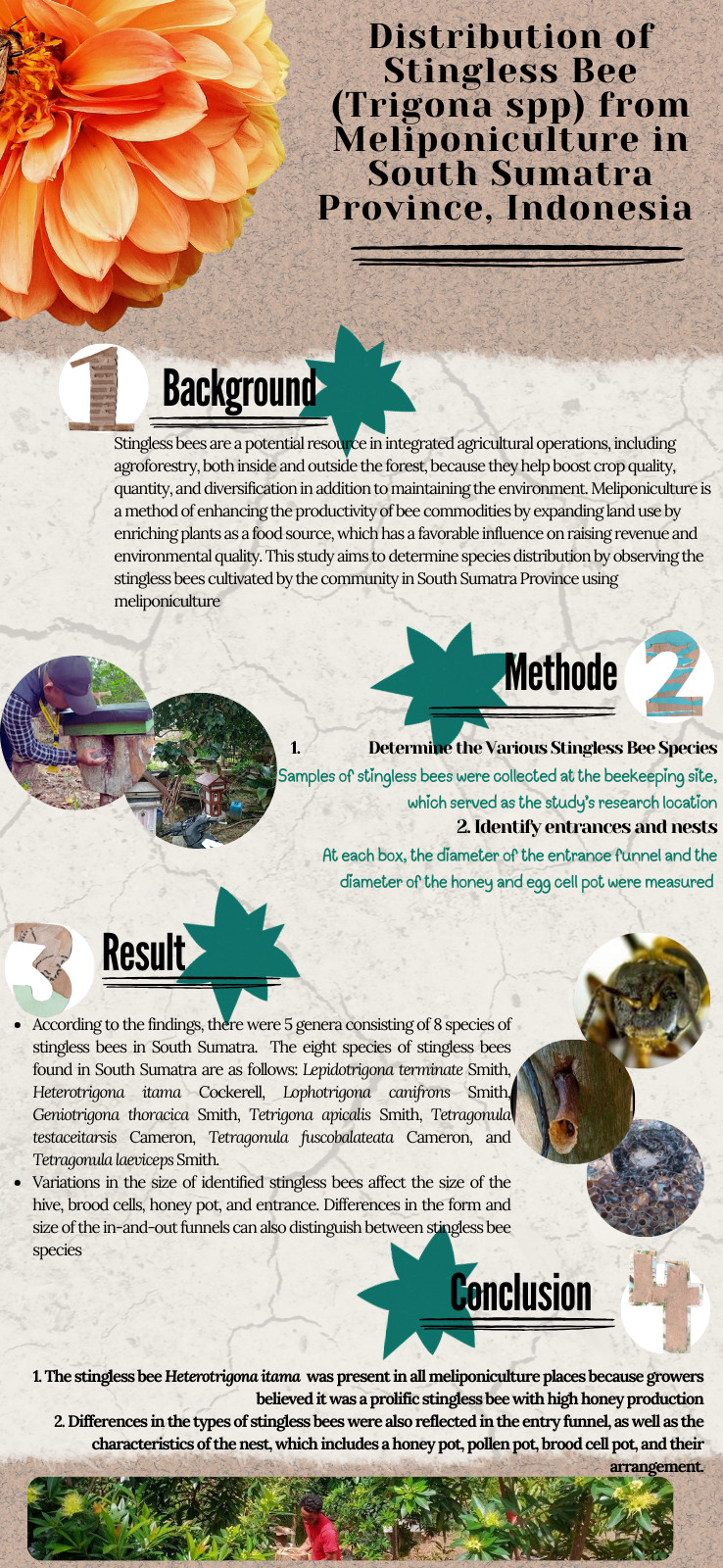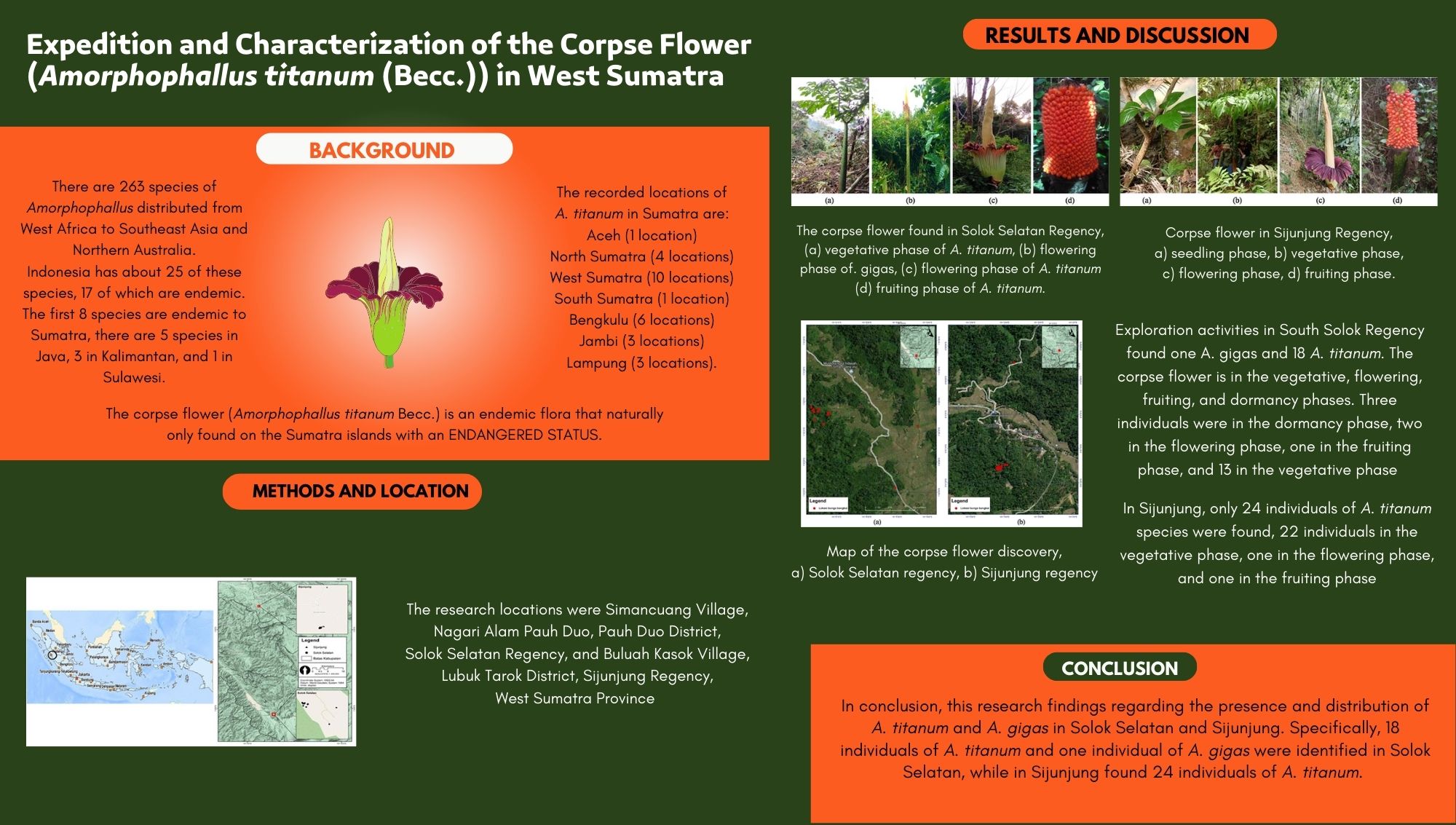Ecological Aspects and Regeneration of Sugar Palm in the Sasak Community Gardens of Kekait Village, West Nusa Tenggara, Indonesia
Abstract
Sugar palm (Arenga pinnata Merr.) is one kind of palm that has multiple benefits on the Sasak community of Kekait Village. Despite its benefit, the information of sugar palm is barely unknown since the farmers depend on the nature cultivation. The Research aimed to analyze ecological aspects: composition, structure, the vegetation distribution, which includes the rate of regeneration and spatial distribution of sugar palm in the Sasak community garden in Kekait Village, West Lombok Regency, West Nusa Tenggara Province. The methods employed in the research is a single plot method with randomly selected. Obtained data are being analyzed quantitatively and qualitatively. The research successfully identified 68 species of 30 families plant. The majority of species are Meliaceae and Anacardiaceae families. The highest IVI from seedlings, saplings, poles, and trees are A. pinnata (52.09%), T. cacao (22.72%), G. gnemon (91.49%), D. zibethinus (80.19%). The vegetation structures showed a well-developed structure. The vegetation distribution in the farmers' garden indicated a clustered pattern within three strata; B, C, and D strata. The regeneration level of A. pinnata categorized as fair sustainable with a clustered distribution pattern. The pattern is affected by the reproduction and distribution of A. pinnata seeds which carried out by Rinjani weasel (Paradoxurus hermaphroditus rinjanicus).
References
Afrianti, U. R. (2007). Ethnobotany study and conservation aspects of sengkubak (Pycnarrhena cauliflora (Miers.) Diels.) in Sintang District, West Kalimantan [thesis]. Bogor: IPB University.
Ariyanti, E. E., & Mudiana, D. (2018). Vegetasi tumbuhan blok hutan waru-waru Cagar Alam Pulau Sempu. Media Konservasi, 23(3), 244–252. https://doi.org/10.29243/medkon.23.3.244-252.
Arrijani. (2008). Vegetation structure and composition of the montane zone of Mount Gede Pangrango National Park. Biodiversitas, 9(2), 134–41. https://doi.org/10.13057.biodiv/d090212
Burkill, I. H. (1935). A dictionary of the economis product of the Malay Peninsula. London: Goverments of Straits Settlements.
Fachrul, M. F. (2012). Bioecological sampling method. Jakarta: Bumi Aksara.
Febriyanti, N., Agus, H., & Zuhud, E. A. M. (2017). The ethnobotany and potential of sugar palm (Arenga pinnata Merr.) on the Kasepuhan Pasir Eurih community, Sindanglaya Village, Lebak Regency, Banten. Media Konservasi, 22(2), 171–80. https://doi.org/10.29244/medkon.22.2.171-180
Ginting, Z. A., Manurung, T. R., & Sisillia, L. (2017). The analisis of vegetation in village forest area in Nanga Yen Village, Hulu Gurung District, Kapus Hulu Regency. Jurnal Hutan Lestari, 5(3), 713–720. http://jurnal.untan.ac.id/index.php/jmfkh/article/viewFile/21464/17390
Gopal, B., & Bhardwaj, N. (1979). Elements of ecology. India: Department of Botany, Rajasthan University Jaipur.
Gunawan, R., Ramadhan, U.G., Iskandar, J., & Partasasmita, R. (2017). Local knowledge of utilization and management of sugar palm (Arenga pinnata) among Cipanggulaan people of Karyamukti, Cianjur (West Java, Indonesia). Biodiversitas, 19(1), 93–105. https://doi.org/10.13057.biodiv/d190115
Heyne, K. (1987). Indonesia useful plants. Volume I-IV. Jakarta: Yayasan Sarana Wana Jaya.
Indriyanto. (2006). Forest ecology. Jakarta: Bumi Aksara.
Kusmana, C. (1997). Vegetation survey methods. Bogor: Bogor Agricultural University.
Lutony, T. L. (1993). Sweetener source plants. Jakarta: Penebar Swadaya.
Mogea, J., Seibert, B., & Smits, W. (1991). Multipurpose palms: The sugar palm (Arenga pinnata (Wurmb) Merr.). Agroforestry Systems, 13(2), 111–29. https://doi.org/10.1007/BF00140236
Morisita, M. (1959). Measuring of Interspecific Association and Similarity between Communities. Faculty of Science, Kyushu University, Series E (Biology), 3, (1) Fukuoka, Japan.
Mueller-Dombois, D., & Ellenberg, H. (1974). Aims and methods of vegetation ecology. New York: New York Wiley.
Muin, A., & Astiani, D. (2018). Population and vegetation structure of ramin (Gonystylus bancanus) in secondary forests of Ketapang District, West Kalimantan, Indonesia. Biodiversitas, 19(2), 478–84. https://doi.org/10.13057.biodiv/d190222
Odum, E. P. (1971). Fundamental of ecology (3th ed.). Philadelphia: W.B. Sounders Company.
Reece, J. B., Urry, L. A., Cain, M. L., Wasserman, S. A., Minorsky, P. V., & Jackson, R. B. (2011). Biology. New York: Pearson Education.
Saharjo, B. H., & Gago, C. (2011). Natural succession after fires at secondary forest in Fatuquero Village, Railaco District, Ermera Regency-Timor Leste. Jurnal Silvikultur Tropika, 2(1), 40–45. Retrieved from http://journal.ipb.ac.id/index.php/jsilvik/article/download/4145/2833
Sanchez-Azofeifa, A., Powers, J. S., Fernandes, G. W., & Quesada, M. (2013). Tropical dry forests in the Americas: ecology, conservation, and management. New York: CRC Press. https://doi.org/10.1201/b15417
Saputra, D., Ardiyansa, Indriyanto, & Duryat. (2016). Composition, structure, and diversity of vegetation types in waterfall Wiyono Atas Wan Abdul Rachman grand forest park in Lampung Province. Sylva Lestari, 4(3), 83–95. https://doi.org/10.23960/jsl3483-96
Shankar, U. (2001). A case of high tree diversity in a Sal (Shorea robusta)-dominated lowland forest of Eastern Himalaya: floristic composition, regeneration and conservation. Current Science, 81(7), 776–86. Retrieved from https://www.researchgate.net/profile/ Uma_Shankar18/publication/237633655
Soegianto, A. (1994). Quantitative ecology; methods of population and community analysis. Jakarta: Penerbit Usaha Nasional.
Soerianegara, I., & Indrawan, A. (1982). Indonesian forest ecology. Bogor: Department of Forest Management, Faculty of Forestry, Bogor Agricultural University.
Sukenti, K., Hakim, L., Indriyani, S., Purwanto, Y., & Matthews, P. J. (2016). Ethnobotanical study on the local cuisine of the Sasak tribe in Lombok Island, Indonesia. Journal of Ethnic Foods, 3, 189–200. https://doi.org/10.1016/j.jef.2016.08.002
Susilowati, Arida, Rachmat, H. H., Elfiati, D., & Hasibuan, M. H. (2019). The composition and diversity of plant species in pasak bumi's (Eurycoma longifolia). Biodiversitas, 20(2), 413–18. https://doi.org/10.13057.biodiv/d200215
Tenda, Elsje, T., Maskromo, I., & Bambang, D. A. N. (2010). East Kalimantan Province exploration of sugar palm (Arenga pinnata Merr.) germplasm in East Kutai, East Kalimantan Province. Buletin Palma, 38, 88–94. https://doi.org/10.21082/bp.v11n38.2010.88-94
Vickery, M. L., & Daubenmire, R. F. (1984). Ecology of tropical plants. New York: Wiley and Sons.
Willson, M. F., & Traveset, A. (2000). The ecology of seed dispersal. In CAB International, Seeds: The Ecology of Regeneration in Plant Communities, 13, 85–110. Retrieved from https://pdfs.semanticscholar.org/8919/ 96f3400977845c67d8b38f2b8e167078facd.pdf
Yusuf, R., Purwaningsih, & Gusman. (2005). Floristic composition and vegetation structure in Rimbo Panti Natural Forest, West Sumatra. Biodiversitas, 6(4), 266–271. https://doi.org/10.13057.biodiv/d060411
Zuhud, E. A. M., Sandra, E., Hikmat, A., Adhiyanto, E., & Siswoyo. (2014). Reference book for medicinal plants in Indonesia. Volume VII. Jakarta: Dian Rakyat.
Authors

This work is licensed under a Creative Commons Attribution 4.0 International License.
Jurnal Manajemen Hutan Tropika is an open access journal which means that all contents is freely available without charge to the user or his/her institution. Users are allowed to read, download, copy, distribute, print, search, or link to the full texts of the articles in this journal without asking prior permission from the publisher or the author. This is in accordance with the Budapest Open Access Initiative (BOAI) definition of open access.








